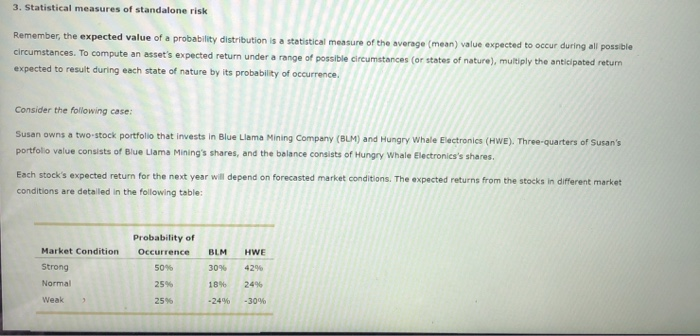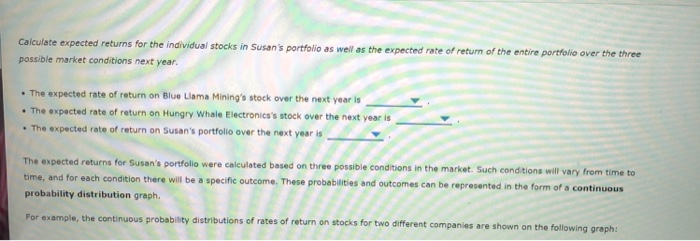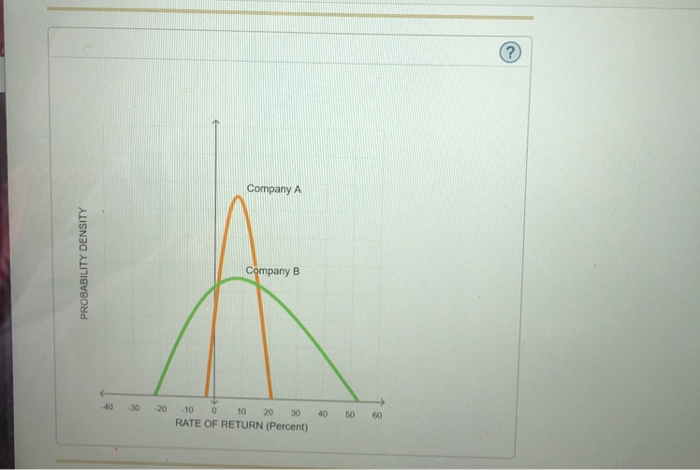3. Statistical measures of standalone risk Remember circumstances. To compute an asset's expected return under a range of possible cireumstances (or states of nature), multiply the anticipated return r, the expected value of a probability distribution is a statistical measure of the average (mean) value expected to occur during all possible expected to result during each state of nature by its probability of occurrence. Consider the following case: Susan owns a two-stock portfolio that invests in Blue Liama Mining Company (BLM) and Hungry Whale Electronics (HWE). Th portfollo value consists of Blue Liama Mining's shares, and the balance consists of Hungry Whale Electronics's shares the next year will depend on forecasted market conditions. The expected returns from the stocks in different market conditions are detalled in the following table: Probability of Market ConditionOccurrence BLM HWE Strong Normal Weak 50% 25% 25% 30% 18% -24% 42% 24% -30% Calculate expected returns for the individual stocks in Susan's portolio as well as the expected rate of return of the possible market conditions next year . The expected rate of return on Blue Llama Mining's stock over the next year is The expacted rate of return on Hungry Whale Electronics's stock over the next year is The expected rate of return on Susan's portfolio over the next year is The expected returns for Susan's portfollo were calculated based on three possible conditions in the market. Such and for each condition there will be a specific outcome. These probabiliti es and outcomes can be represented in the form of a continuous probability distribution graph For example, the continuous probability distributions of rates of return on stocks for two different companias are show Calculate expected returns for the individual stocks in Susan's portfolio as well as the expected rate of return of the entire portfolio over possible market conditions next year The expected rate of return on Blue Llama Mining's stock over the next year is . The expected rate of return on Hungry Whale Electronics's stock over the next The expected rate of return on Susan's portfolio over the next year is 11.48% 18.23% The expected returns for Susan's portfolio were calculated based on three possib time, and for each condition there will be a specific outcome. These probabilities probability distribution graph. in the market. Such conditions will vary from aes can be represented in the form of a contin 20% 13.50% For example, the continuous probability distributions of rates of return on stocks for two different companies are s Calculate expected returns for the individual stocks in Susan's portfolio as well as the expected rate of return of the entire portfolio over the three possible market conditions next year. The expected rate of return on Blue Llama Mining's stock over the next year is The expected rate of return on Hungry Whale Electronics's stock over the next year is . The expected rate of return on Susan's portfolilo over the next year s _ 19.50% expected returns for Susan's portfolio were calculated based on three possible condi time, and for each condition there will be a specific outcome. These probabilities and out probability distribution graph. 24 18% market. Such conditions will vary from time to be represented in the form of a continuous 22.04% 12.68% For example, the continuous probability distributions of rates of return on stocks for two mpanies are shown on the following graph: Calculete expected returns for the individual stocks in Susan's portf possible market conditions next year. olio as well as the expected rate of return of the entire portfolio over the three The expected rate of return on Blue Llama Mining's stock over the next year isN of return on Hungry Whale Electronics's stock over the next year is The expected rate of return on Susan's portfolio over the next year is The expected returns for Susan's portfolio were calculated based on thre! 15.00% time, and for each condition there wil be a specific outcome. These probability distribution graph. onditions in the market. Such conditions will vary from time to outcomes can be represented in the form of a continuous prot 20.25% 12.75% 18.00% For example, the continuous probability distributions of rates of return t two different companies are shown on the following graph Company A ny B 40 3020 10 10 20 30 40 50 60 RATE OF RETURN (Percent)












